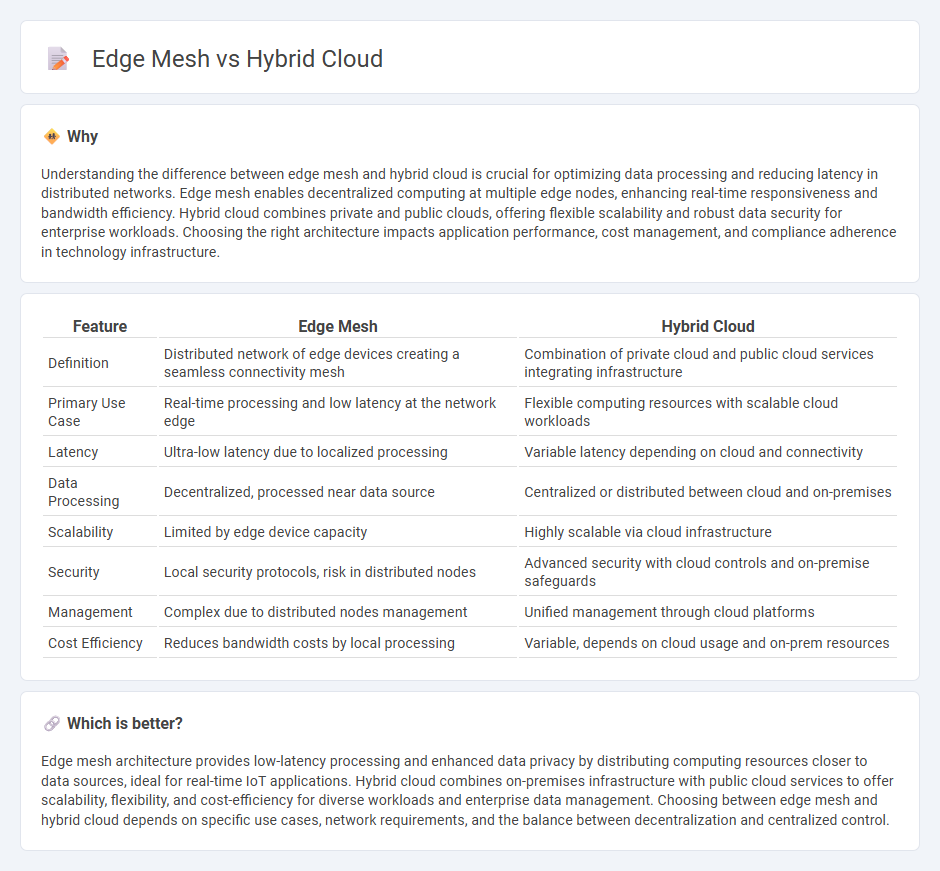
Edge mesh technology enhances data processing by distributing workloads across interconnected edge devices, reducing latency and improving real-time analytics. Hybrid cloud combines private and public cloud infrastructures to optimize scalability, security, and resource management for enterprises. Explore the key differences and benefits of edge mesh versus hybrid cloud to determine the best fit for your technology strategy.
Why it is important
Understanding the difference between edge mesh and hybrid cloud is crucial for optimizing data processing and reducing latency in distributed networks. Edge mesh enables decentralized computing at multiple edge nodes, enhancing real-time responsiveness and bandwidth efficiency. Hybrid cloud combines private and public clouds, offering flexible scalability and robust data security for enterprise workloads. Choosing the right architecture impacts application performance, cost management, and compliance adherence in technology infrastructure.
Comparison Table
| Feature | Edge Mesh | Hybrid Cloud |
|---|---|---|
| Definition | Distributed network of edge devices creating a seamless connectivity mesh | Combination of private cloud and public cloud services integrating infrastructure |
| Primary Use Case | Real-time processing and low latency at the network edge | Flexible computing resources with scalable cloud workloads |
| Latency | Ultra-low latency due to localized processing | Variable latency depending on cloud and connectivity |
| Data Processing | Decentralized, processed near data source | Centralized or distributed between cloud and on-premises |
| Scalability | Limited by edge device capacity | Highly scalable via cloud infrastructure |
| Security | Local security protocols, risk in distributed nodes | Advanced security with cloud controls and on-premise safeguards |
| Management | Complex due to distributed nodes management | Unified management through cloud platforms |
| Cost Efficiency | Reduces bandwidth costs by local processing | Variable, depends on cloud usage and on-prem resources |
Which is better?
Edge mesh architecture provides low-latency processing and enhanced data privacy by distributing computing resources closer to data sources, ideal for real-time IoT applications. Hybrid cloud combines on-premises infrastructure with public cloud services to offer scalability, flexibility, and cost-efficiency for diverse workloads and enterprise data management. Choosing between edge mesh and hybrid cloud depends on specific use cases, network requirements, and the balance between decentralization and centralized control.
Connection
Edge mesh and hybrid cloud architectures enhance data processing by distributing computational resources closer to the source of data generation while leveraging centralized cloud infrastructures for scalability and management. Edge mesh enables seamless connectivity between multiple edge devices, facilitating low-latency communication and real-time analytics, which complements the hybrid cloud's ability to integrate private and public cloud services. This combination optimizes workload distribution, improves data security, and reduces bandwidth usage across complex IT environments.
Key Terms
Data Sovereignty
Hybrid cloud combines private and public clouds to optimize data storage and processing, while edge mesh distributes computing closer to data sources, enhancing real-time data control. Data sovereignty is critical in both models; hybrid cloud ensures compliance through region-specific data residency, whereas edge mesh enforces local data governance by processing data at the network edge. Explore how these architectures balance performance and regulatory demands in data sovereignty.
Latency
Hybrid cloud architecture centralizes data processing in remote data centers which can introduce higher latency due to longer data transmission paths. Edge mesh computing distributes workloads closer to the data source by leveraging interconnected edge nodes, significantly reducing response times and improving latency-sensitive applications. Explore how choosing between hybrid cloud and edge mesh can optimize latency for your specific use cases.
Workload Distribution
Hybrid cloud leverages centralized cloud resources combined with on-premises infrastructure to optimize workload distribution by balancing scalability and control. Edge mesh distributes workloads across interconnected edge devices, reducing latency and enhancing real-time data processing at the network's periphery. Explore the advantages of both architectures to determine the best strategy for your workload distribution needs.
Source and External Links
What is a Hybrid Cloud? - A hybrid cloud is a computing environment combining resources and services from multiple environments such as public clouds and on-premises infrastructure, offering agility, integration, and flexibility to meet business and compliance needs.
What is hybrid cloud? - Hybrid cloud infrastructure blends on-premises systems, private clouds, and public clouds like AWS or Azure, enabling businesses to achieve agility and support digital transformation while balancing cost and efficiency.
What is Hybrid Cloud? - Hybrid cloud integrates internal IT resources with third-party cloud services, allowing businesses to scale, manage compute resources centrally, ensure business continuity, and accelerate development by leveraging multiple environments seamlessly.
 dowidth.com
dowidth.com